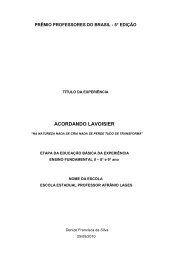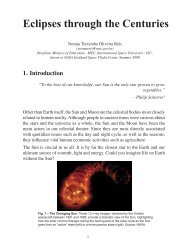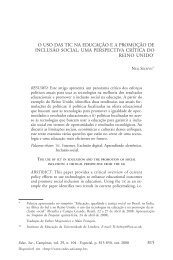BIO-CULTURAL COMMUNITY PROTOCOLS - Portal do Professor
BIO-CULTURAL COMMUNITY PROTOCOLS - Portal do Professor
BIO-CULTURAL COMMUNITY PROTOCOLS - Portal do Professor
You also want an ePaper? Increase the reach of your titles
YUMPU automatically turns print PDFs into web optimized ePapers that Google loves.
PART I / CHAPTER 2<br />
relationship with the ecosystem. Studies in the Kumbhalgarh<br />
Sanctuary have shown not only how the panther population<br />
in the region has been sustained by our livestock, but also the<br />
negative impacts caused by the exclusion of livestock from the<br />
Sanctuary such as conflict over increased encroachment by<br />
panthers into villages.<br />
Just as our breeds are unique because of the areas we graze<br />
them in, so the forests, gauchar and oran have evolved into<br />
particular kinds of pastoral-based ecosystems because of our<br />
long-term interaction with them. We are integral to the forests,<br />
gauchar and oran: we cannot survive without them and they<br />
will suffer without us. 6<br />
The Samburu pastoralists in Kenya explain that they have<br />
a symbiotic relationship with the land, stating that as keepers<br />
of indigenous and exotic breeds of livestock, their lives are<br />
interlinked with and wholly dependent on their animals.<br />
Because their way of life also allows them to coexist with<br />
wildlife, they promote the in situ conservation of biodiversity.<br />
In their BCP, they say:<br />
We live in an area of the world that is incredibly rich in plants,<br />
wildlife and other environmental resources. Many parts of the<br />
world used to be populated by wild animals that ranged across<br />
the land, but have been depopulated because of the actions<br />
of man. In contrast, wherever possible we live alongside<br />
important animals such as lions, elephants, zebras, gazelles,<br />
klipspringers and wild <strong>do</strong>gs. Near watering holes you will also<br />
see bustards, the world’s heaviest bird, as well as hornbills and<br />
birds of prey such as eagles.<br />
We also have customary laws that guard against<br />
environmental degradation. For example, a recent decision<br />
by the Loisukutan Forest Committee has determined that,<br />
because of the importance of the forest for fruits, honey, water<br />
and wildlife, its use for grazing and wood must be limited. The<br />
committee also decides about access to seasonal grazing areas.<br />
Our pastoral way of life promotes the conservation of our<br />
important indigenous breeds of livestock alongside world<br />
renowned wildlife. We have a right to continue to live according<br />
to our values that promote the sustainable use of our livestock<br />
while ensuring conservation of the wider environment. 7<br />
6. Supra note 4.<br />
7. Supra note 2.<br />
<strong>BIO</strong>-<strong>CULTURAL</strong> <strong>COMMUNITY</strong> <strong>PROTOCOLS</strong> AS A<br />
<strong>COMMUNITY</strong>-BASED RESPONSE TO THE CBD<br />
3.3 Conserving Medicinal Plants and<br />
Animal Genetic Resources<br />
3.3.1 Medicinal Plants and Culture<br />
The traditional healers we spoke to all explained how they<br />
hold TK about the uses of certain plants, and as a result,<br />
they specifically set out to conserve the plants from which<br />
they sustainably harvested. In this case, TK leads directly to<br />
conservation. The Gunis of Rajasthan, for example, have<br />
three specific ways in which they conserve the medicinal<br />
plants they use. The following is an excerpt from their BCP:<br />
As a group, we conserve medicinal plants through home<br />
herbal gardens and dharam bageechas (self-managed<br />
medicinal plants development areas) and share our<br />
knowledge with each other and our students to ensure its<br />
continued development. In this way, the valuing of our<br />
knowledge by our communities leads to conservation, and<br />
the sustainable use of medicinal plants is leading to the<br />
development of traditional knowledge.<br />
Herbal gardens: We each have our own herbal gardens at our<br />
houses in which we grow the most important plants. Often these<br />
gardens are up to half an acre in size. We feel that every home<br />
should have an herbal garden and promote the growing of the<br />
most widely used plants for common ailments by villagers near<br />
their homes and along the verges of fields. Presently, there are<br />
already over 10,000 herbal gardens in Rajasthan, but we want<br />
to promote a further increase in numbers.<br />
Dharam Bageechis: Some of us have been given land by the<br />
village on which to grow medicinal plants in a wild setting,<br />
which we call dharam bageechis. Dharma is translated into<br />
English as meaning selflessness or selfless service, and<br />
bageechis is orchard. Thus dharam bageechis literally<br />
means “gardens of service.” While we look after the areas, we<br />
see them as a community resource upon which we draw to<br />
treat community members. By closing the area to grazing,<br />
many medicinal plants grow leading to their regeneration to<br />
naturally abundant levels. We also specifically propagate<br />
certain species that are not initially found within the dharam<br />
bageechis or are particularly endangered.<br />
24

















